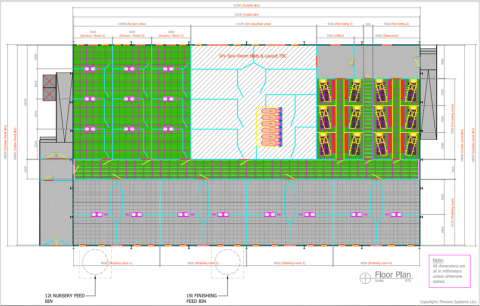Glynllifon Agricultural College Project Introduction: Predatory flies to biologically control pest flies in pig units
Address: Glynllifon Agricultural College, Clynnog Rd, Penygroes
Technical Officer: Dafydd Owen
Project Title: Predatory flies to biologically control pest flies in pig units
Project Introduction:
Glynllifon is a land-based campus situated on the Glynllifon Estate near Caernarfon. Recent investments at the farm include a state-of-the-art pig unit that consists of a herd of 50 hybrid Rattlerow WhiteLand sows. Although there are two boars on site, most gilts and sows are served using AI. The modern facility is insulated and has an automated ventilating system so that temperatures in each room are controlled to keep pigs warm in winter and cool during the summer months. The flooring is slatted, so that slurry is collected in tanks and used for first-cut silage to reduce fertiliser costs. The unit has been subdivided into 10 enclosed rooms (Figure 1) including 2 farrowing rooms, 3 nursery/grower rooms, 4 fattening rooms and 1 dry sow area.
Flies have recently been an issue in the unit, especially in the finishing rooms.
The presence of flies can not only cause a nuisance to both staff and the pigs, but flies can also carry diseases; they can spread over 100 different pathogens, such as salmonella spp and transmit more than 65 human and animal intestinal diseases, eye disease and can infect wounds and skin. Flies can also have a significant effect on productivity due to a reduction in feed intake, resulting in serious economic losses.
The house fly is the most common species affecting the pigs at Glynllifon. They can complete their lifecycle in as little as seven days in the warmer summer months.
As only 15% of the total fly population are adult at any one time, killing adult flies alone will not control the problem effectively.
With pressure mounting on chemical use on farm and resistance being promoted due to the same adulticides continuously being used, the project will be looking at using predatory flies (Biofly) as a biological control to break the fly life cycle and ultimately control fly numbers. The Biofly (Hydrotea aenescens) is a natural enemy of pest flies which targets fly larvae often found in wet muck areas.
How does the Biofly work?
The adult will fly just a few inches above the slurry (under slats) and will begin laying eggs after being released. The eggs develop into larvae which will actively consume pest fly larvae in the slurry, breaking the life cycle of the fly.
The fly larvae predator develops in the slurry without the need to predate on fly larvae, so can sustain its self even when fly larvae levels are low.
Figure 1. Glynllifon pig unit Floor Plan
Aim of the project:
The main aim of the project is to try and reduce the number of house flies in the pig unit to improve productivity and animal health and welfare. This will be done by introducing and evaluating the effectiveness of using fly larvae predators as a biological fly control.
What will be done:
- Pre-trial fly data collection
- 4 x 1ft sections of fly tape will be located in 7 rooms (3 nursery rooms and 4 finishing rooms).
- 1 nursery room (Nursery 1) and 2 finisher rooms (Finisher 3, 4) will be control rooms. The fly tapes will be put up on a Monday, the number of flies will be counted on the following Thursday and again on the following Monday. The tapes will then be taken down and replaced with clean ones.
- This will be repeated for three weeks.
- The chosen location for the fly tapes will be consistent across all rooms.
2. Releasing Biofly (protocol in table below)
- 1 x Biofly sachet contains ~9000 Biofly pupae
- 1 x Biomite tube/ room will be used initially for first release due to late start in the fly season as a corrective treatment
3. Post fly releasing data collection
- Data collection protocol will be the same as the pre-trial data collection.
- Assessments will be made to compare pre- and post- fly numbers.

